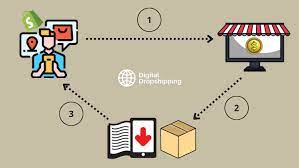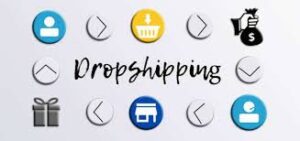What is Digital Dropshipping Products: 7 Best Ideas to Boost

Digital dropshipping, also known as digital product dropshipping or e-dropshipping, (digital drop shipping) is a variation of the traditional dropshipping model that focuses on selling digital products instead of physical goods. In digital dropshipping, the products being sold are intangible and can be delivered electronically, such as e-books, software, online courses, music, graphics, templates, and other digital downloads.
What Is Digital Dropshipping?
Digital dropshipping is a variation of traditional dropshipping that involves selling digital products instead of physical goods. By partnering with third-party suppliers, entrepreneurs can sell digital products they don’t own or create and have them fulfill orders. This approach has gained popularity due to the growing demand for digital products and the convenience of using e-commerce platforms. Platforms like Shopify, WooCommerce, and Wix are commonly used for digital dropshipping businesses.

Why is digital dropshipping a good business idea?
Digital dropshipping offers a low-cost, flexible, and scalable business opportunity. Without the need for physical storage, you can operate from anywhere and start as a part-time venture. The wide range of digital products available allows for niche specialization. As your business grows, scaling up is simple since you don’t have to deal with physical inventory constraints. Overall, digital dropshipping presents an appealing business idea with various advantages for aspiring entrepreneurs.
How Digital Dropshipping Works
Digital dropshipping enables retailers to sell a diverse range of products without upfront costs or inventory risks, as suppliers handle fulfillment. This mutually beneficial arrangement expands the sales channel for both parties involved.
Here’s a breakdown of how digital dropshipping works in a bullet point format:
- Retailer finds products to sell: They search for in-demand digital products and connect with suppliers/creators willing to dropship these products.
- Retailers set up an online store: They create a website or online storefront to showcase and sell the products.
- Customer places order: Customers browse the retailer’s online store, select a product, and provide payment and shipping details.
- Retailer notifies supplier: Once an order is placed, the retailer promptly notifies the supplier with the customer and payment information.
- Supplier fulfills the order: The supplier validates the payment and delivers the digital product directly to the customer, such as by emailing a download link or providing access to an online course.
- The retailer receives commission: The supplier deducts an agreed commission from the sale amount and transfers the remaining funds to the retailer.
- The supplier delivers directly to the customer: The supplier handles all fulfillment and delivers the digital product directly to the customer through email or other online channels.
- Retailer avoids inventory management: The retailer never possesses or handles physical inventory, as the supplier is responsible for product storage and delivery.
This process allows the retailer to focus on marketing, customer service, and expanding their product offerings while leveraging the supplier’s expertise in fulfillment and product delivery.
Dropshipping suppliers for digital products
When it comes to digital dropshipping, selecting the right suppliers is crucial. Some leading dropshipping suppliers for digital products include:
- AliExpress: Offers a vast range of digital products and has a large supplier network.
- Oberlo: Specializes in connecting Shopify stores with digital product suppliers.
- CJDropshipping: Provides a wide selection of digital products and integrates with various e-commerce platforms.
- Creative Market: Focuses on digital design assets, such as graphics, fonts, and templates.
- ClickBank: A popular affiliate marketing platform with a wide range of digital products available for promotion.
- Printful: Some leading dropshipping suppliers in the digital products industry offer white-label services, enabling you to sell products under your brand. Their broad product range makes it easy to diversify your offerings.
- Udemy: Udemy’s extensive catalog, recurring revenue from new releases, absence of fulfillment, and global reach and credibility make it an exceptional supplier for digital dropshipping.
Platforms for Digital Dropshipping
- Shopify
- WooCommerce
- Wix
- Etsy
How to start a digital dropshipping business

Launching a digital dropshipping store can indeed be a relatively straightforward process. Key steps include identifying a successful digital product, establishing a reliable supplier relationship, and creating an online website to showcase and promote your business.
Sure! Here’s a breakdown of how to dropship digital products and the steps involved in setting up a digital dropshipping business:
- Choose your dropshipping niche: Pick a niche aligned with your interests and analyze market demand and competition.
- Select your digital products: Look for trending or in-demand digital products with favorable profit margins.
- Find reliable suppliers: Research suppliers for reliability and quality, considering reviews and ordering samples.
- Set up your online store: Choose an e-commerce platform like Wix that supports digital dropshipping and integrates with suppliers.
- Create your brand: Develop a strong brand identity with a memorable name, logo, and color scheme. Craft a compelling brand story.
- Develop your marketing strategy: Determine effective marketing strategies for your target audience, utilizing social media and online advertising.
How to find your digital dropshipping item
Market Research:
- Understand your target audience: Identify their interests, pain points, and needs.
- Use tools like Google Trends, social media analytics, and forums to spot trends and hot topics.
- Look for gaps in the market where your digital products can provide value.
Keyword Research:
- Utilize keyword research tools like Google Keyword Planner or Ubersuggest.
- Identify search terms related to your potential products.
- Focus on high search volumes with low competition keywords to target potential niches.
Competition Analysis:
- Research successful digital drop shippers in your chosen niche.
- Analyze their offerings and identify what’s missing or can be improved upon.
- Gain insights from their product offerings and marketing strategies.
Customer Feedback:
- Pay attention to customer reviews and comments on e-commerce platforms and social media.
- Look for expressed desires for specific digital products, features, or improvements.
- Use this feedback to shape your product selection and business strategy.
How to find a reliable supplier for your digital dropshipping store?
In dropshipping, whether the products are physical or digital, a significant drawback is the lack of control over product quality. Additionally, the choice of suppliers directly impacts your profit margin. Therefore, conducting thorough research and being selective about the suppliers you work with is crucial.
To find reliable suppliers for your digital dropshipping business, consider the following steps:
- Use reputable online platforms: Explore established platforms like Amazon Kindle, Udemy, or specialized digital marketplaces that offer a range of digital products and reliable suppliers.
- Research potential suppliers: Look for suppliers that align with your chosen niche. Research their reputation, reviews, and track record of product delivery to assess their reliability.
- Contact and communicate: Reach out to potential suppliers to inquire about their products, pricing, and dropshipping arrangements. Assess their communication responsiveness and clarity.
- Check product quality: Request samples or access to their digital products to evaluate the quality. Ensure the products meet your standards and the expectations of your customers.
- Verify licensing and rights: Confirm that the supplier possesses the necessary licenses and rights to distribute the digital products, ensuring you avoid copyright infringement issues.
- Discuss terms and agreements: Establish clear terms and agreements regarding pricing, payment methods, order processing, and any other relevant details. Ensure everything is documented in writing to protect both parties.
- Start with a small order: Begin with a small order to test the supplier’s reliability, product quality, and shipping process before committing to a long-term partnership.
Is Digital Dropshipping Profitable?
Digital dropshipping offers several advantages that contribute to its growing demand and popularity. Here are some key benefits:
- Great Demand: The digital economy’s increasing demand for digital products creates a favorable environment for digital dropshipping, ranging from educational materials to digital tools and templates.
- Low Investment & High Return: Digital dropshipping requires minimal upfront investment since there’s no need to invest in physical inventory or manage shipping logistics. This cost-efficiency allows for a high return on investment, making it an attractive option for entrepreneurs.
- Easy to Create & Distribute: Digital products can be created based on personal interests, abilities, and experiences. They can be easily delivered and distributed through automated processes, eliminating the need for physical shipping and enhancing the customer experience.
- Never Out of Stock: Digital products are always in stock, eliminating the frustration of running out of inventory during high demand periods.
- Lower Barrier to Entry: Launching a digital dropshipping business has fewer complexities and lower barriers to entry compared to traditional retail, making it accessible to a wider range of entrepreneurs.
- Environmentally Friendly: Digital dropshipping is inherently eco-friendly. It reduces the carbon footprint associated with traditional retail by minimizing physical production, transportation, and waste. Customers receive digital goods without contributing to packaging or shipping waste, making it a sustainable choice.
Marketing Strategies for Digital Dropshipping Products
Dropshipping digital products is a lucrative business model that aligns with the future of commerce. It offers accessibility, and convenience, and caters to evolving consumer preferences in an increasingly digital world.
1. Google Ads
Google Ads is an effective tool for showcasing digital products in search results, capturing the attention of potential customers actively searching for specific items. Conducting thorough keyword research and crafting compelling ad copy is crucial for attracting and engaging your target audience.
To maximize the impact of your digital dropshipping business, it’s essential to implement a social media strategy. This involves regular posting, engaging with your audience, and utilizing relevant hashtags. Social media enables you to connect with potential customers, raise brand awareness, and cultivate a loyal following that can drive traffic to your store.
3. Influencer Marketing
To effectively execute your social media strategy, it’s crucial to identify influencers whose followers match your target customer base. You can engage with influencers through direct collaborations or by compensating them for promotional efforts. Leveraging influencer marketing can significantly boost brand exposure and drive sales for your digital dropshipping business.
Email marketing is a powerful tool for enticing subscribers to visit your store and make purchases. By providing value through regular newsletters, promotional emails, and exclusive content, you can effectively engage with your audience and drive sales. Consistency in communication is key.
5. Search Engine Optimization (SEO) Marketing
To achieve success with SEO, it’s important to conduct keyword research, create high-quality product descriptions, and enhance your website’s user experience. Building backlinks from reputable sources can also boost your site’s authority and visibility in search engine rankings.
6. Content Marketing
To establish your brand as an authority and build trust with your audience, create diverse and valuable content such as blog posts, video tutorials, and infographics. By offering valuable resources and information, you position your brand as an expert in your niche.
Affiliate marketing offers the advantage of leveraging the promotional efforts of others to expand your reach and boost sales. To ensure success, a well-designed affiliate program should offer competitive commission rates, provide marketing materials, and offer support to affiliates.
8. Social Proof
To maximize the impact of social proof, create dedicated sections on your product pages for customer reviews. Encourage satisfied customers to leave reviews and share testimonials through different marketing channels. Social proof enhances credibility and instills confidence in potential buyers, boosting your sales.
7 Best Digital Dropshipping Products To Sell
When selecting profitable digital products for your dropshipping business, it is essential to ensure compliance with copyright and patent laws. Respecting intellectual property rights is crucial to avoid legal issues and maintain ethical business practices.

Now, let’s take a look at dropship digital products:
- eBooks
- Audiobooks
- Fonts
- Digital Templates & Tools
- Artwork
- Photography
- Software Programs
- Guides
Tips for Success in Digital Dropshipping
Digital dropshipping offers several advantages over traditional dropshipping of physical items. You can sell digital products multiple times without dealing with shipping costs or handling fees.
- Focusing on a specific niche: Choose a niche that aligns with your interests and expertise, allowing you to cater to the unique needs and preferences of your target audience. This focus will also ensure long-term selling opportunities.
- Building a strong brand identity: Develop a memorable brand that resonates with your target audience and sets you apart from the competition. Even though you’re not creating the product, you’re still selling the customer on why the product is the right solution for their problem. A strong brand identity will facilitate future sales.
- Providing exceptional customer service: Offer timely and helpful support to your customers to enhance their experience and encourage repeat business. Go above and beyond to meet their needs and address any concerns that may arise.
- Staying up-to-date with industry trends and best practices: Continuously research and learn about new developments in digital dropshipping, e-commerce, and marketing to keep your business ahead of the curve. Stay informed about emerging trends and adapt your strategies accordingly.
- Continuously optimizing marketing strategies: Regularly monitor the performance of your marketing efforts and make data-driven decisions to refine and improve your strategies over time. Test different approaches, analyze results, and make adjustments to maximize your marketing effectiveness.
- Spocket Dropshipping Reviews: Your Best Fulfillment Partners
- Best Oberlo Chrome Extension Download App for Dropshipping
- Dropshipping Salehoo Review: Can You Make Money With Salehoo
- 10 Top Shopify Dropshipping Stores Examples in 2024
- 10 Best Websites Like Temu: Apps like Temu to Get Free Stuff
- What is Digital Dropshipping Products: 7 Best Ideas to Boost




